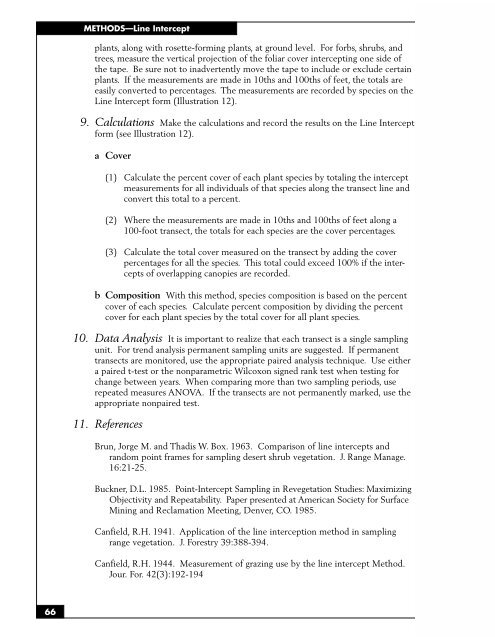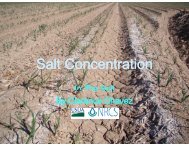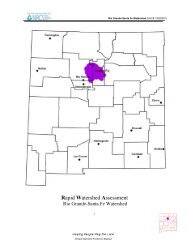SAMPLING VEGETATION ATTRIBUTES - New Mexico NRCS - US ...
SAMPLING VEGETATION ATTRIBUTES - New Mexico NRCS - US ...
SAMPLING VEGETATION ATTRIBUTES - New Mexico NRCS - US ...
Create successful ePaper yourself
Turn your PDF publications into a flip-book with our unique Google optimized e-Paper software.
66<br />
METHODS—Line Intercept<br />
plants, along with rosette-forming plants, at ground level. For forbs, shrubs, and<br />
trees, measure the vertical projection of the foliar cover intercepting one side of<br />
the tape. Be sure not to inadvertently move the tape to include or exclude certain<br />
plants. If the measurements are made in 10ths and 100ths of feet, the totals are<br />
easily converted to percentages. The measurements are recorded by species on the<br />
Line Intercept form (Illustration 12).<br />
9. Calculations Make the calculations and record the results on the Line Intercept<br />
form (see Illustration 12).<br />
a Cover<br />
(1) Calculate the percent cover of each plant species by totaling the intercept<br />
measurements for all individuals of that species along the transect line and<br />
convert this total to a percent.<br />
(2) Where the measurements are made in 10ths and 100ths of feet along a<br />
100-foot transect, the totals for each species are the cover percentages.<br />
(3) Calculate the total cover measured on the transect by adding the cover<br />
percentages for all the species. This total could exceed 100% if the intercepts<br />
of overlapping canopies are recorded.<br />
b Composition With this method, species composition is based on the percent<br />
cover of each species. Calculate percent composition by dividing the percent<br />
cover for each plant species by the total cover for all plant species.<br />
10. Data Analysis It is important to realize that each transect is a single sampling<br />
unit. For trend analysis permanent sampling units are suggested. If permanent<br />
transects are monitored, use the appropriate paired analysis technique. Use either<br />
a paired t-test or the nonparametric Wilcoxon signed rank test when testing for<br />
change between years. When comparing more than two sampling periods, use<br />
repeated measures ANOVA. If the transects are not permanently marked, use the<br />
appropriate nonpaired test.<br />
11. References<br />
Brun, Jorge M. and Thadis W. Box. 1963. Comparison of line intercepts and<br />
random point frames for sampling desert shrub vegetation. J. Range Manage.<br />
16:21-25.<br />
Buckner, D.L. 1985. Point-Intercept Sampling in Revegetation Studies: Maximizing<br />
Objectivity and Repeatability. Paper presented at American Society for Surface<br />
Mining and Reclamation Meeting, Denver, CO. 1985.<br />
Canfield, R.H. 1941. Application of the line interception method in sampling<br />
range vegetation. J. Forestry 39:388-394.<br />
Canfield, R.H. 1944. Measurement of grazing use by the line intercept Method.<br />
Jour. For. 42(3):192-194




